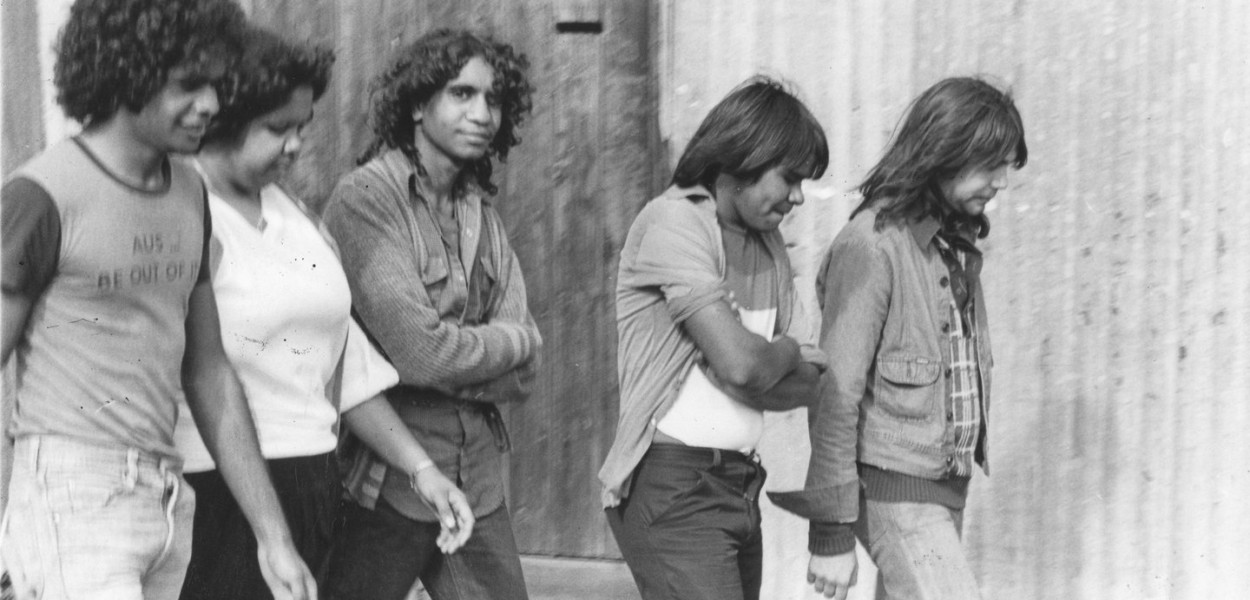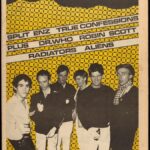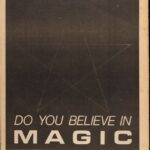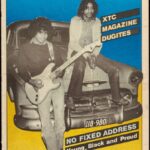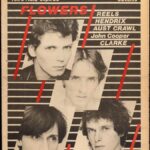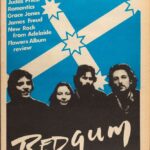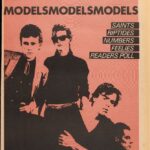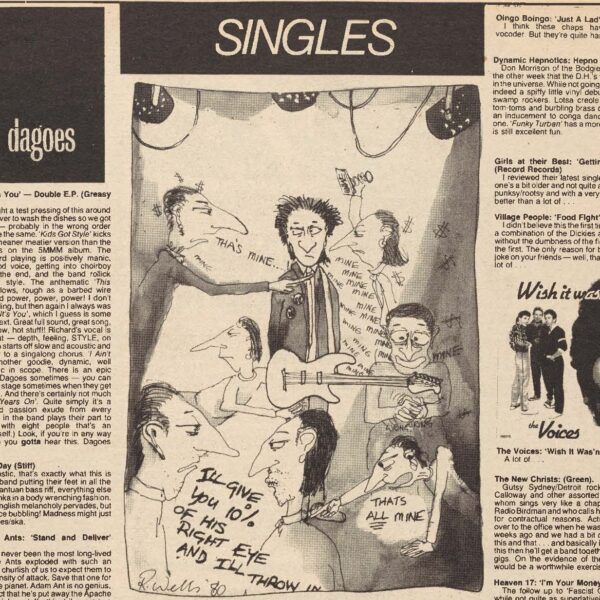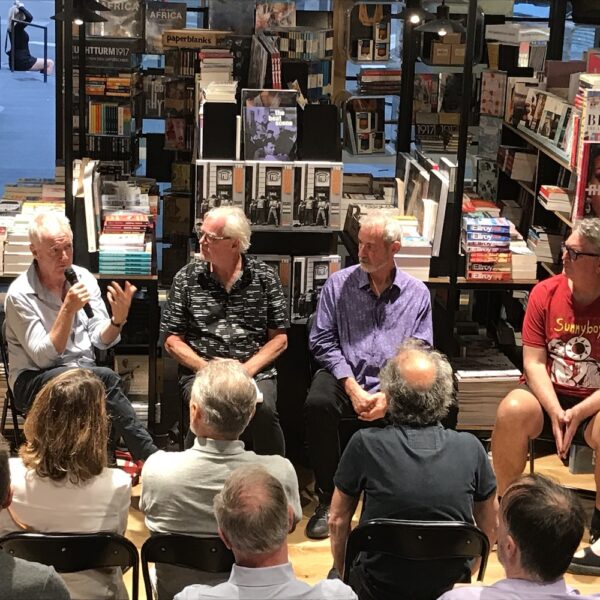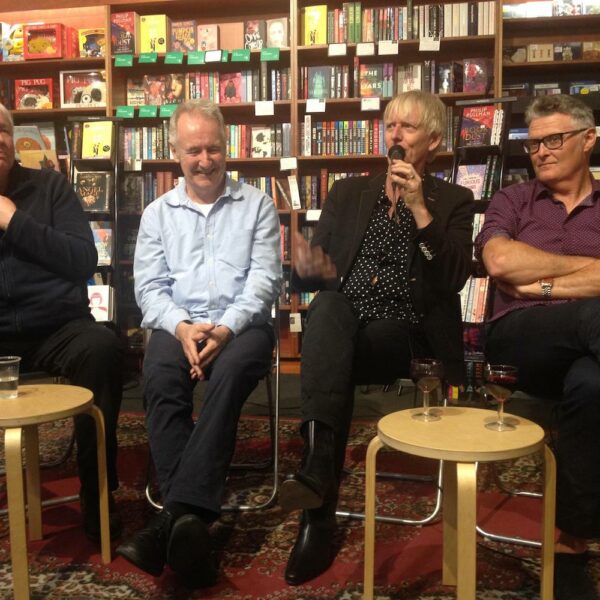To view and download issues, click on thumbnails below
- February 1980
- March 1980
- April 1980
- May 1980
- June 1980
- July 1980
- August 1980
- September 1980
- October 1980
Roadrunner’s ‘End of the ’70s’ double issue in December 1979 made a few people sit up and take notice. One of them was Paul Gardiner, publisher of Rolling Stone.
Gardiner used to play the occasional game of squash with Stuart Coupe in Sydney and asked him if I might be willing to sell the magazine. He had just started a new publication, The Record (edited by Ed St John), and was looking for another title—with the new wave/new band content that Roadrunner contained—to really put the squeeze on his main competitor, RAM.
Coupe told Gardiner to get in touch, which he did, inviting me to Sydney for a meeting. Gardiner, a former Australian Financial Review journalist and obviously no mug, also engaged credit reporters Dun & Bradstreet to check Roadrunner‘s long-term operations, credit history, profitability and stability. Shortly afterwards, I received a questionnaire from Dun & Bradstreet asking for all sorts of information about circulation, advertising revenue, production costs, assets and liabilities etc. Wary of revealing to a competitor how penurious Roadrunner really was, I sent advertising manager Robbie James to Sydney to suss out Gardiner. According to Coupe, Gardiner was less than impressed that I didn’t take the meeting. I didn’t complete the survey and Gardiner’s interest lapsed.
Attempting to publish the magazine fortnightly at the beginning of 1980 was a misstep and one that was quickly exposed as an overreach. Three issues into the year, I was explaining to Bruce Milne and other contributors that going fortnightly, ‘has been rather a strain on the financial and production structure of the paper. Which is why we haven’t strictly been fortnightly—more like three weekly—this year, so far.’ The difficulty was still cash flow.
‘The big problem is, as always, the slowness of the advertisers and distributors to pay. Because we (or I) haven’t got any finance behind us (or me) we almost need the money from the previous edition in order to print the next one. So if that money is late then so is the next edition. The Melbourne Birthday Party benefit was set up to put that financial safety net under the paper, but while it was a pretty good night and a reasonable promotional exercise, it didn’t really put a lot of money in the bank. Ever heard of tightrope walking?’
Roadrunner‘s Second Birthday Party was a concert at Melbourne’s Crystal Ballroom in St Kilda on 10 February 1980 featuring The Sports, Boys Next Door and Adelaide band Lemmy Caution. The door price was $6, promoter Laurie Richards donated the venue and the bands donated their services (although I seem to recall the road crew got paid and there was a looooooong free list on the door). Lemmy Caution paid their way over from Adelaide for the exposure. There were a few tense moments when The Sports’ crew squared up to the Boys Next Door crew about placement of equipment, but a call to Mushroom HQ at Dundas Lane seemed to resolve the issue. A highlight of the night was the inaugural Roadrunner Rock Awards, compered by Red Symons and Wilbur Wilde. The poll results were included in the issue of 22 February.
As the Age reported on Monday 11 February:
‘The Australian band Sports stole the scene at the ‘Roadrunner’ Rock Awards in the Crystal Ballroom, St. Kilda, last night. Although it spent 11 months overseas last year, the band won—in the Australian section—best group, best album for ‘Don’t Throw Stones’ and best songwriter, guitarist Martin Armiger. Joe Camilleri of Jo Jo Zep was rated best male vocalist and Angie Pepper of The Passengers won the best female vocalist award.
‘Readers of the national rock paper ‘Roadrunner’, who were polled for the awards, thought Mental as Anything was the tip for 1980 and gave it the best single title for ‘The Nips Are Getting Bigger’. Best live group went to The Angels, best television rock show was won by ‘Nightmoves’ and in the overseas section Talking Heads took best group, The B-52s won best album and Bruce Springsteen won best songwriter.’
Chris Salewicz, the London-based journalist who wrote for New Musical Express, contributed a lengthy two-part feature on The Clash for the first two issues of 1980 (dated 8 and 22 February). As RAM and Juke regularly ran reprints of articles from New Musical Express and Melody Maker, via syndication deals with their publishers, some readers mistakenly assumed that Roadrunner had succumbed to the same practice. In an editorial in the 22 February issue, I pointed out this was not the case. Salewicz contributed directly to Roadrunner, I confirmed, and the magazine continued to publish 100 per cent original material. The editorial prompted a nice response from John Magowan, editor of the Canberra-based Record Buyers Guide. John wrote:
‘I’d just like to offer my congratulations on the expression of an attitude long overdue in this country. As someone who buys and reads nearly all available music magazines from Australia and overseas it’s a pleasure to see an Australian mag that has the courage and integrity to aggressively assert its own originality.
‘For too long Australian rock fans have been forced to accept the appearance of identical articles in several different magazines simply because from the viewpoint of the local publishers it’s easier and less expensive to reprint an article than it is to generate the material here in Australia or to offer a financial commission to an overseas writer.
‘Wishing you every success for the best rock’n’roll newspaper in the country.’
Gee thanks, John!
The advantages of having writers on the spot was again on display in Vol 3. No. 3 (April). The cover had Mental as Anything’s Greedy Smith hamming it up in front of Buckingham Palace and the cover story was by Chris Willis, an Adelaide journalist on his rite of passage to the Old Dart. (More recently, Willis was a long-time news director at Sydney’s Channel 7.) Also in London, Keith Shadwick dropped round to John Lydon’s place for a wide-ranging chat about Public Image Limited’s Metal Box (and other matters). The ensuing interview, in Q & A format, was liberally sprinkled with colourful language. Up at Bridge Press, Adrian Dibben noticed this while making the page negatives and alerted his boss, Mike Hambridge. Hambridge instructed Dibben to white out all the swear words. Whatever, I said. What else could I do? There were so many, Dibben missed a few. As you can see if you read the piece.
Murray Cammick from Rip It Up, which was like Roadrunner‘s New Zealand cousin, also got in touch, sending a couple of issues and enclosing a feature interview done with someone over the phone (the letter I have doesn’t say who) which he said we were free to use. I don’t think we did, but we struck up a correspondence and he sent some great photos of New Zealand’s Sweetwater Festival, held between 24 and 26 January 1981, that we used on the cover of the first issue of 1981.
Some further unexpected recognition came in the form of a voting form for the industry awards in the inaugural TV WEEK Rock Music Awards.
The covering letter read: ‘As a journalist with a recognised affinity for rock music, TV WEEK is officially inviting you to register your vote in a number of categories in the Special Awards section of the TV WEEK Rock Awards. These awards are voted for by the rock press and radio throughout Australia … ‘
I still have a copy of my voting form. For the calendar year 1979, I adjudged Mental as Anything Best New Talent and Best Single for ‘The Nips Are Getting Bigger’. Best album and album cover I gave to Jo Jo Zep and the Falcons for Screaming Targets. Best producer I thought was Mark Opitz, best songwriter Kevin Stanton from Mi-Sex and most outstanding achievement The Angels.
The award presentations were held at the Comedy Theatre, Melbourne, and broadcast live on ABC-TV’s Countdown on Sunday, 13 April. Mi-Sex took out Best New Talent and Best Single (‘Computer Games’), while their producer Peter Dawkins took out Best Producer. Best Album Cover went to Cold Chisel’s Breakfast at Sweethearts. Little River Band won awards for Best Album (First Under the Wire) and Most Outstanding Achievement. UK-based Terry Britten was adjudged Best Songwriter.
The new wave was obviously beginning to encroach on the established order and by the following year, all the winners were firmly within Roadrunner‘s orbit.
I accepted an invitation to attend the awards, booked a ticket on the Overland and took the opportunity to convene a gathering of all the Melbourne-based Roadrunnerites that weekend.
The upshot of the meeting was that Adrian Ryan, who had been contributing some finely written pieces since July 1979, became Melbourne editor, Bruce Milne handed over the role of distributing the magazine to Melbourne import record shops to John Cummings while Robbie James, who had relocated to Melbourne, departed as advertising manager and was replaced by Adelaide-based Lyn Saunders.
These changes were reflected in Vol 3. No. 4, which was printed on 14 April for the period 18 April–1 May. Michael Hope wrote the cover story on Split Enz. Eric Algra took the black-and-white cover photo in the alley beside Adelaide’s Thebarton Town Hall after an Enz concert. In an editor’s note I wrote: ‘First of all, my apologies for the delay between this issue and the last one. Perhaps we were a little hasty in going fortnightly at the time we did—but you learn by your mistakes and so in the last month we have been setting up a stronger organisational structure that WILL enable us to come out fortnightly.’
Vol 3 No 5 with a cover story by Coupe on Jimmy Page’s fascination with magic, came out in mid-May for the period 21 May—4 June. Err, what happened to the period 2–20 May?
Eventually I did learn from my mistake and Vol 3. No 6, with Doc Neeson of The Angels on the cover, was dated July. Vol 3 No 7, with a cover photo of No Fixed Address by Eric Algra, was dated August—and there was no more talk of a fortnightly.
The No Fixed Address cover was a bold call—putting any unsigned band, let alone a young, Adelaide-based, Aboriginal reggae band, on the cover of a music magazine was pretty much unprecedented—but I found the rationale pretty compelling. As I wrote in my intro to the cover story:
‘For a whole lot of reasons, political, historical and musical, No Fixed Address is probably the most important new group in this country today. The voice that they speak with has been too often suppressed in the last two hundred years. It’s about time it was heard.’
Over the next two years, No Fixed Address did a national tour supporting Cold Chisel, supported The Clash at its Magnificent Seven shows at Sydney’s Capitol Theatre, supported Peter Tosh on his Australian tour, signed to Rough Diamond Records and toured the UK.
There was a rather poignant news item in that August 1980 issue. It read:
‘If you are a burglar and you’re thinking of burgling the ROADRUNNER office—don’t bother. Someone’s already done it. Sometime on the weekend of 2nd August, persons unknown broke into the office and took the office stereo, a swag of albums and just about all the new release singles. As a result, there are no singles reviews this issue … if you know somebody whose record collection has tripled overnight, we’d love to hear from you.’
On the business side of things, for some time I had been exasperated by poor distribution in Victoria and Queensland.
Early in the year I approached Gordon & Gotch to distribute the paper in all states bar New South Wales, where Allan Rodney Wright had been doing a great job for more than twelve months. They were interested, but only if they could have all Australian states. So reluctantly, I agreed, parted with Allan Rodney Wright, and G & G distributed nationally (and into New Zealand) from April 1980 onwards.
Figures for paid circulation, advertising revenue and production costs in 1980 survive and give a snapshot of the magazine’s precarious financial position.
Newsagency sales for the eight issues distributed by G & G in 1980 averaged 4309, which broke down geographically as: NSW 35 per cent, Vic/Tas 24.3 per cent, SA, 18.6 per cent, Qld 8.5 per cent, WA 5.3 per cent and New Zealand 8.2 per cent. The best-selling issue was July with 5075 copies and the poorest was October with 3224.
With a cover price of 60 cents, the return to the magazine was nominally 50 per cent (30 cents). However, once the cost of freighting the issue around the country was deducted, the effective return was about 23.5 cents. So revenue from newsagency sales averaged $1011 per issue.
The average advertising revenue per issue for 1980 was $2301, although this fluctuated widely, from a high of $3405 (June) to a low of $770 (October).
Average production cost per issue was $2321. This included printing, typesetting, freight, layout and bromides (photo reproduction). This meant there was, on paper, around a thousand dollars per month to pay for everything else—my (modest) living expenses, office rent, electricity, office supplies, advertising commission and—unfortunately, last in the food chain—contributors. In practice, slow cash flow meant that when money came in, it almost always went straight out again to pay an overdue bill. We always seemed to be chasing our tail.
The figures also demonstrate how important increasing advertising revenue was to the paper’s survival. Adding a thousand newsagency sales would net the paper a paltry $235. Adding an extra full-page ad—$280, less 10 per cent commission—a net $252.
There was a significant turnover in contributors in 1980. Departures included one-time co-editor and Melbourne editor Bruce Milne, whose Au Go Go Records had become more of a serious proposition, and 2JJ presenter and Sydney correspondent Stuart Matchett, who was deeply involved in Double Jay’s move to the FM band and rebadging as 2JJJ. Contributions from Clinton Walker, another former Melbourne editor, petered out to the odd record review as he decided he preferred getting paid for his writing by Rolling Stone and RAM—and who could blame him? Walker collected 13 published articles (and numerous photos) from Roadrunner contributors to include in Inner City Sound (Wild & Woolley, 1982) his seminal overview of punk/post-punk music in Australia 1976-81. The book attained legendary status and, after many years out of print, was republished by Verse Chorus Press of Portland, Oregon, in 2005.
Ross Stapleton headed for London and a position in the Virgin Records press office where he started pushing albums, singles and interview opportunities the way of the paper. In September, Scott Matheson, who’d been an absolute stalwart in Brisbane, providing features, reviews and even distributing the magazine to record stores, wrote from Sydney to tell me his band, The Riptides, had moved to the Harbour City six weeks previously and despite all their initial gigs being blown out, ‘must have picked up a street vibe pretty quickly because now we work 4 or 5 times a week and [booking agency] Nucleus are right behind us and we’ve made a couple of trips to Melbourne and one to Brisbane in the meantime.’ He went on:
‘I guess it’s about time I put my journalistic aspirations into abeyance and concentrated on The Riptides. Not that I ever spent much time writing, it’s just that it seemed to get me into so much trouble all the time.
‘So I’m just enjoying being Scott Matheson who plays guitar in The Riptides in Sydney, rather than as I was in Brisbane Scott Matheson that creep who writes about his own band in Roadrunner. Brisbane is such a funny place. I mean, I only wanted to write for Roadrunner because I was a fan of the music and I thought it was about time people found out what was happening in Brisbane. I hardly think I used Roadrunner as a platform for The Riptides and in all honesty (though this doesn’t mean much because Brisbane is such a tiny place), The Riptides were the most popular band in Brisbane it terms of the people we could pull to gigs.’
Bravo, Scott. And later, after he left The Riptides, Matheson picked up his pen and resumed writing for the magazine from Sydney.
Elly McDonald was a prolific Sydney contributor in 1980, with features on Cold Chisel, INXS, The Radiators, The Lonely Hearts, Skyhooks, Flowers, Jimmy and The Boys, The Reels and The Dugites. David Langsam chipped in features and reviews from Melbourne and Kim Williams continued to lob good stuff over the Nullarbor from Perth. Craig N Pearce, a hot new talent from Melbourne, sent his first reviews in October—he would become a prodigious contributor in the months ahead. And in that same issue James Manning, later publisher of the Australian Smash Hits and Mediaweek magazines, contributed a review of a benefit concert for community radio station 3RRR, held at the Melbourne University Union Building. Manning saw thirteen different bands, including Mental as Anything, Australian Crawl, Paul Kelly and The Dots, Matt Finish, The Dynamic Hepnotics and MEO 245. Way to go James!
Geoffrey Gifford bowed out in August. Art direction was taken over by Richard Turner, who shared Gifford’s studio, and Kate Monger joined the layout team. Gifford still contributed the odd design, including the superb cover and centrespread on Flowers for the September issue. Since Gifford was doing the design of their debut album, Icehouse, for Regular Records, he was able to utilise the excellent shots of the band taken by Grant Matthews.
We were all working on the final issue of 1980, December 1980-January 1981, in Gifford’s studio in the east end of Rundle Street, near the Exeter Hotel, when the news hit. It was mid-afternoon on Tuesday, 9 December 1980. John Lennon’s been shot. And killed.
We stopped what we were doing, of course. And just talked. Geoffrey, Richard, Kate and myself. And after a couple of hours I went home and wrote what became the cover story of that issue. I was devastated but it helped to have something to do, an opportunity to say something. And I always felt the cover, a young Lennon in a doorway in Hamburg, with subtle tints of red and yellow, was one of Roadrunner‘s best.


